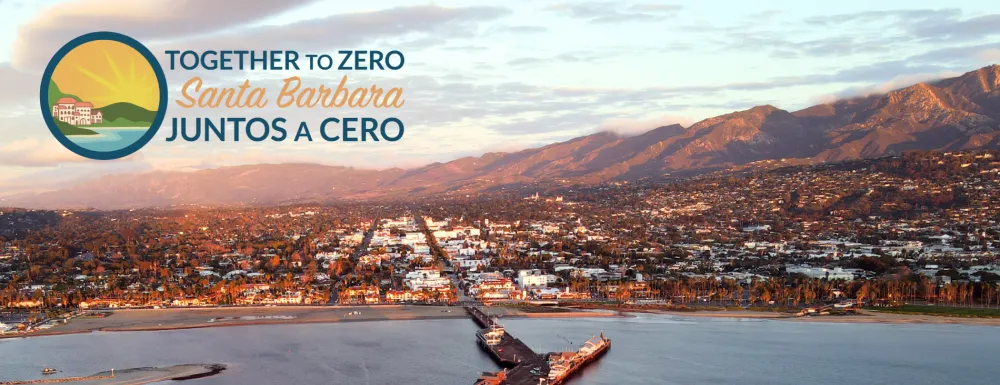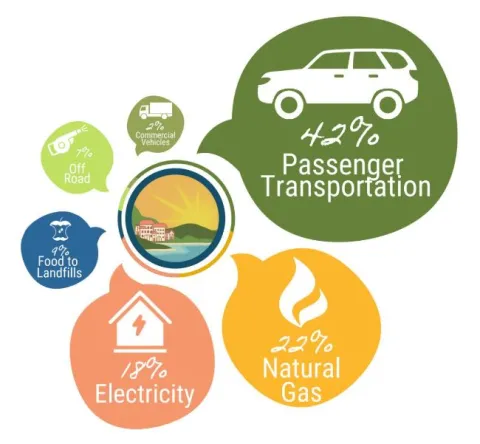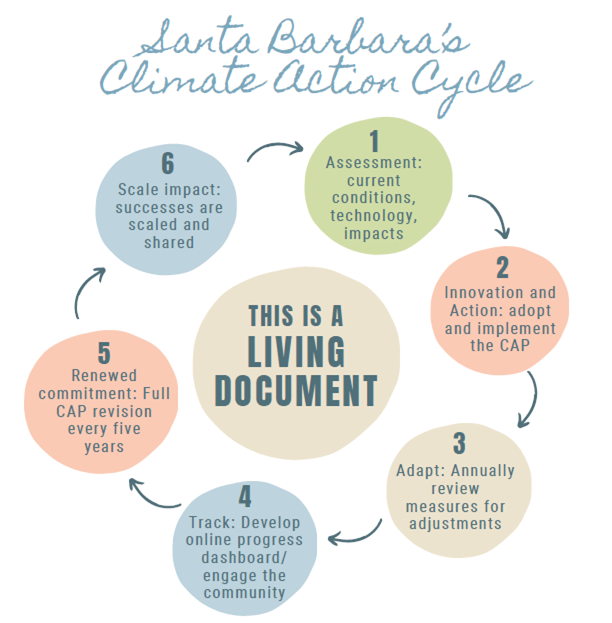
Climate Action Plan
CAP Documents:
Contact
Sustainability@SantaBarbaraCA.gov
(805) 564-5631
Together to Zero
City Council has adopted the aspirational climate goal of achieving carbon neutrality by 2035. The City of Santa Barbara’s new Climate Action Plan (CAP), entitled Together to Zero, serves as the City’s roadmap to achieve this goal through reducing GHG emissions across the City and new strategies to remove carbon from the atmosphere. Implementing Together to Zero will reduce emissions from all municipal, residential, and commercial sectors within City bounds.
On this page you can learn about where the City’s emissions come from and how we plan to reduce those emissions.
The graphic below is a snapshot of the City of Santa Barbara’s emissions in the most recent greenhouse gas inventory in 2019.

The majority of the City’s emissions come from the transportation sector – primarily single occupancy vehicle trips. You can learn more about the City’s strategy to reduce those emissions in the Transportation section of the CAP.
The City took a giant leap to reducing emissions from the electricity sector with the 2021 launch of Santa Barbara Clean Energy, the City-run electricity provider that provides 100% carbon free energy from sources like solar, wind, and hydropower to Santa Barbara homes and businesses.
As emissions have essentially been eliminated from our electricity supply, a big emphasis of the Climate Action Plan is reducing natural gas consumption. In the Building Energy section below you can learn about the strategies to move towards cleaner, more efficient electrical appliances in our buildings.
The emissions from food to landfills come from the methane produced by solid waste, which the County's ReSource Center captures and turns into energy, running their facility and more than 3,000 homes annually. By shrinking the percentage of emissions from each sector, we’re working as a community towards carbon neutrality.
In 2019, Santa Barbara City Council set a local goal of carbon neutrality by 2035. Since then, the amount of emissions per person has decreased - we're well on our way to carbon neutrality!
Based on the 2019 GHG Emissions inventory, the Climate Action Plan was created to set the City on a course towards carbon neutrality. The projected reductions in emissions from all the measures and actions in the CAP were estimated and calculated. Those reductions are shown in the graph below.
You can see in the graph that while the measures in the CAP do not get us all the way to carbon neutrality by 2035, they represent a huge start and the most ambitious and significant GHG reductions in the history of the City. This plan creates the inflection point on our journey to zero and lays the groundwork for future GHG reductions.
Santa Barbara local goal of carbon neutrality by 2035.
The City of Santa Barbara is not starting from scratch on its quest for carbon neutrality. Many policies, programs and projects have been implemented that have set the Climate Action Plan up for success. For example, the City's Green Building Policy is currently being implemented to reduce natural gas consumption in the City’s buildings. Implementation of the City's Zero Emission Vehicle Acquisition Policy is under way, as are the Bicycle Master Plan and Pedestrian Master Plan, which reduce carbon emissions from transportation. The City has already banned several single use plastic items that are not recyclable, and has partnered with libraries and other community hubs to promote reuse and repair programs, including leveraging the Santa Barbara Public Library’s Library of Things.
The strategies to get the City to carbon neutrality also promote resilience against climate events. The City’s Community Wildfire Protection Plan is designed to reduce fire risk and carbon loss due to wildfires by conducting vegetation management throughout the City.
Together to Zero will help us get the rest of the way. Efforts such as electrifying our fleet, upgrading our buildings, and increasing active transportation opportunities for our community make this goal a reality. Read more about each section of the Climate Action Plan below.
We believe that achieving carbon neutrality is not just about reducing our impact on the environment. It's also about creating a more equitable and just community for all residents and building resilient communities through programs and infrastructure to overcome the challenges of climate change. The CAP outlines ways in which we are protecting and prioritizing our under-resourced community. This means identifying barriers to electrification and implementing programs to overcome them, planting trees in low-comes neighborhoods with limited canopies, and ensuring access to safe and sustainable transportation, be it walking, biking, or car travel. Together to Zero is a goal we can only reach as a whole community, and the CAP strives to elevate opportunities for everyone to get involved and benefit from carbon-neutrality.
As we move Together to Zero, achieving carbon neutrality will be a complex and multifaceted challenge that involves transforming various aspects of energy consumption, infrastructure, transportation, AND behavior, while also relying on State and Federal governments to remain bold and ambitious. The CAP outlines a “10-year plan” of strategies we intend to undertake over the next decade given the best information we have today, and a “2-year plan” detailing the strategies either in process or quickly planned, for which funding and capacity currently exist.
There are five sections in the CAP, each focused on how to bring our community closer to carbon neutrality by 2035. The Sustainability & Resilience team invites you to explore each section, detailed in the drop down menus below, and the full document.

| The Goal | Eliminate emissions from the building sector by increasing energy efficiency and converting new and existing buildings to all-electric systems. Add new local renewable energy sources to increase resilience and meet local demand. |
| Centering Equity | The City is developing programs and incentives to electrify multi-family buildings, thus reducing energy costs for renters while simultaneously enhancing indoor air quality and health. |
| City Leadership | The City has adopted a Green Building Policy. All new City facilities will be highly efficient, zero-net-energy buildings capable of producing enough electricity on-site to run the building. The City has set a goal to convert all its facilities to all-electric by 2035. |
| The Strategy | Offer a suite of tools, education, and incentives, coupled with thoughtful regulation to accelerate conversion to all-electric buildings. |
Santa Barbara’s building stock currently relies heavily on natural gas. Therefore, GHG emissions from the City’s existing buildings must be reduced to achieve the City’s climate action targets. By implementing the measures outlined in this section, the City of Santa Barbara will reduce natural gas consumption through electrification of the City’s building stock. By leveraging SBCE’s 100% carbon-free energy, all-electric buildings are powered 100% by electricity. When coupled with renewable electricity generation, their operational energy footprint becomes GHG emissions free.
The CAP’s Building Energy Measures provide the framework of updated regulations, programs, funding mechanisms, education, and advocacy to drive electrification of both new and existing residential and commercial buildings.
View Building Energy Measures and Actions
| The Goal | Promote use of safe, equitable, zero emission transportation options to reduce pollution and urban congestion today and for future generations. |
| Centering Equity | Provide incentives, programs, pathways, and infrastructure to promote adoption of sustainable transportation options for ALL members of our community. |
| City Leadership | The City adopted a "Zero Emission Vehicle First" purchasing policy for City fleet vehicles. The City manages an electric bike share program (BCycle). The City employee WorkTRIP Program encourages carpooling, mass-transit, and active modes of commuting. |
| The Strategy | Innovate and collaborate with residents, businesses, workforce, and stakeholders to build a more climate-centric transportation system. Improve infrastructure for active transportation modes such as biking and walking, strengthen electric vehicle charging network, and promote conversion to zero emission vehicles. |
Transportation emissions make up the biggest share of Santa Barbara’s total emissions. The City has many existing programs to support sustainable transportation. In order to meet our carbon-neutrality goal, the City must further reduce emissions from passenger vehicles. The City’s transportation strategy consists of a multi-pronged approach for incentivizing alternatives to fossil fuel-powered vehicle trips, including shifting transportation mode share to active transportation and public transit options, electrifying passenger and commercial vehicle trips, and decarbonizing off-road equipment. By promoting safe, equitable, zero-emission transportation our City will reduce transportation emissions by 40%, bringing carbon-neutrality that much closer.
| The Goal | Increase the City's ability to remove carbon from the atmosphere. |
| Centering Equity | Prioritizing low-income areas in the City with less existing tree canopy for new shade tree plantings. When there are localized co-benefits for sequestration projects focus development benefits to historically adversely impacted under-resourced communities. |
| City Leadership | City manages a Creek Tree Program, Urban Forestry Program, and compost application program. A City and County partnership with the ReSource Center provides compost for residents and businesses and maximizes organic food waste diversion from the landfill. |
| The Strategy | Bolster the City's planting programs and vegetation management to ensure landscaping and habitats provide the most resilience and GHG reduction potential. Partner with resilience initiatives for co-benefits. Look at programs and measures that will accomplish multiple benefits like increasing resilience and shade for heat events and making sure that our plantings are appropriate for extreme heat and drought events. Increasing the use of compost and increasing drought tolerant and shade creating landscapes. |
The CAP aims to leverage natural systems to remove carbon from the atmosphere. When the measures in this section are implemented, 4,500 new trees will be sequestering carbon in our community by 2030. These new trees will be prioritized in areas with less existing tree canopy, creating shade as well as sinking carbon. Existing restoration projects will be maintained and expanded to continue sequestering carbon. Carbon sequestration is an opportunity for Santa Barbara to equitably promote sustainable resilience while moving together to zero.
| The Goal | Reduce organics in the solid waste stream and reduce or reuse other resources. Reduce use of landfill space, the demand for water, and consumption of single use plastics and other materials that have multiple environmental impacts. |
| Centering Equity | Provide multilingual and industry specific education for all residents and ensure there are cost effective and accessible means for residents to participate in initiatives. |
| City Leadership | The City partners with the County on the ReSource Center to convert commercial and residential waste into resources by recovering recyclable materials, transforming organics into landscape nutrients, and generating renewable energy. The City has instituted an aggresive water conservation program and implements the Water Conservation Strategic Plan. |
| The Strategy | Reduce the use of packaging, single use items, and other materials; produce and distribute compost; and ensure efficiency in the City's recycling and waste processes. Implement the City's Water Conservation Strategic Plan and increase drought tolerant landscaping. |
Much is being done at the state and local level to reduce emissions from water, wastewater, and solid waste. The CAP focuses on high impact actions, that when implemented will reduce local emissions by 98%. The biggest share of these emissions is waste to landfills. Santa Barbara goes above and beyond state requirements to keep our waste minimal and maximize the life and health of the Tajiguas Landfill and our state-of-the-art ReSource Center. Santa Barbara has banned items that do not have means of recycling, like polystyrene and plastic straws, and aims to collaborate with partners to develop a regional compost trading program. We are striving as a community to reduce our waste production, and by keeping our waste low, we reduce our emissions.
View Water, Wastewater, Solid Waste Measures and Actions
| The Goal | Establish Santa Barbara as a national leader in green technology innovation and economic development. |
| Centering Equity | Develop grant and scholarship programs to encourage participation from local students to get involved in green technology and innovation projects. |
| City Leadership | The City created a comprehensive Sustainability and Resilience Department which is developing innovative programs, solutions, and strategies around clean energy, green building, watershed management, and waste reduction. |
| The Strategy | Develop partnerships with local schools and institutions of higher learning to spur climate innovation and workforce development. |
Building community potential refers to building the collective capacity, capabilities, and resources within our community to combat climate change. It encompasses skills, talents, knowledge, and social capital of community members, as well as physical and economic resources. The concept emphasizes the idea that communities like ours have inherent strengths and assets that, when leveraged, can contribute to their overall resilience, sustainability, and quality of life.
View Community Potential Measures and Actions
Next Steps
The fight against climate change is not a once-fought battle; it is an iterative process of innovation, adaptation, and collective resilience. Each step forward propels us closer to a sustainable, carbon-neutral future.
Achieving carbon neutrality will require state and federal legislation, funding, advancements in technology, and continued community education and empowerment. Because of this, the Climate Action Plan must be a dynamic, living document, assessed and adapted regularly to address changes in the landscape.
The City commits to reviewing the plan annually and adapting the priorities and timeline to current developments and best practices. Additionally, we commit to taking inventory of our local greenhouse gas emissions at least every five years and incorporating the results into renewed commitments and strategies.

The CAP is a dynamic document that will be reviewed annually to assess progress and priorities. The contents of the CAP will change based on new information, new data, and best practices.
Thank you for reading the 2024 Climate Action Plan. Our Team is excited to move Together to Zero with you!
